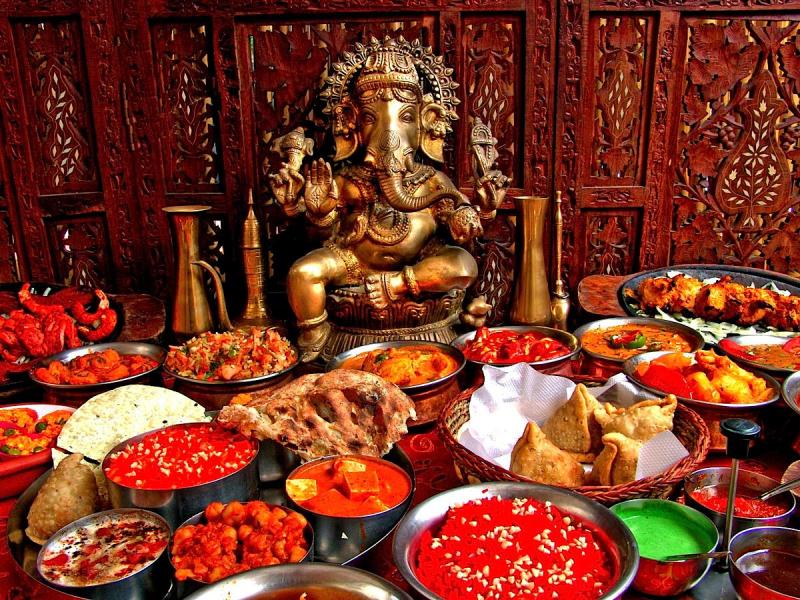
Indian Food and Culture
By Mark Johnson
The cuisine of India is reflective of the country’s great size and 5000-year history. The convergence of a vast variety of differing cultures and groups within the country has resulted in a varied and diverse definition of the national cuisine. India spans through a multitude of different climates, terrains and soil types, and the religions of its citizens, which can greatly affect their choice of diet, changes from region to region. Outsider influence has also caused changes within Indian cuisine, and Portugal is often credited with introducing the potato to the country. Many of the national dishes contain several of the same popular staple ingredients, including: lentils, spices and rice. But this is one of few instances of connectivity within a varied and hard to define cuisine.
Biryani
Biryani is a rice based dish made with spices. The rice is usually basmati, which is served with a mixture of main ingredients, such as chicken, fish, eggs, mutton or vegetables. Its name comes from the Persian word beryā, asit originated in Persia, when it was invented in the kitchens of the Mughal Emperors. Like the majority of Indian dishes, it comes in a large number of varieties. The dishes main appeal is the contrasting flavours of its ingredients, unlike other Indian dishes; the rice is cooked separately from the sauce, and the portions of meat and vegetables. The two are then layered together, instead of being mixed, leaving several powerful and distinct flavours within one dish. The intensity of its tastes and the traditional size of its portions mean that it is often best enjoyed as a one-dish meal.
Chole Bhature
This Indian dish gets its name from its two primary ingredients. A Chole is a spicy chick pea, and Bhature is the name of a fried type of bread made from maida flour. The soft and spongy bhature is used to soak up the chole. The dish is usually eaten as a snack or as part of a heavy breakfast, when eaten this way it is generally served with green onions, onions, carrot pickle, or achaar, which is a south Asian pickle. Many slight variants on the core dish exist, including the aloo bhatura and paneer bhatura, in the first the bread is filled with boiled potato, and in the second cottage cheese. Extra twists can be added to its flavour by adding pieces of ginger, chilli powder, or even tea leaves.
Bikaneri Bhujia
Nowhere quite shows the impact that a region’s geography has upon its cuisine quite like Rajasthani, the area, known as ‘the land of kings’, is the largest state in the Republic of India and covers 10.4% of the country. Its boundaries contain a large portion of the Thar Desert, and the Aravalli Mountain Range. These large stretches of arid and harsh land have had a significant influence on the regions food. The lack of water and vegetables has resulted in the majority of their dishes being simple snack dishes. One of the most common food items from Rajasthani is Bikaneri Bhujia, a crisp snack that is made from gram flour and spices. Its other ingredients can include moth beans, black pepper, salt, red chilli, cloves, cardamom, and groundnut oil. Once the dough is made it is pushed through a sieve and fried in vegetable oil, when it is properly cooked it turns a light shade of yellow.
Gujia/Pedakiya/Karanji/Ghughra
Despite the differences between some of India’s regions, they will sometimes independently create a dish that is similar to one that originated within another. A classic Rajasthani desert is a sweet dumpling made from suji or Maida Flour and stuffed with a Khoya, a milked based food that is similar to cheese. In Rajasthani this sweet dumpling is known as a Gujia, where it is famed for its distinctive shape, and is stuffed with grated fruit, that is dried or roasted, alongside the Khoya. Many other regions have a similar dish but its name or fillings vary. In the northern state of Bihar they are very popular, and known as Pedakiyas. The recipe slightly varies and the dumpling is sometimes deep fried in ghee, a clarified butter that originates from South Asia. Variants of the snack exist within Maharashtra, where it is known as Karanji, and in Gujarat, where it is usually stuffed with coconut and called Ghughra. In Southern and Western India it is consumed around Diwali. The country has a variety of names for it, and saves it for a number of occasions, but it reoccurs throughout the national cuisine and is enjoy by a significant percentage of India’s population.
Vindaloo
Vindaloo is undoubtedly one of the most well known Indian dishes outside of the India; it has become a staple on Curry house menus across of Britain and other western countries, where it is famed for its intense heat and spiciness. While it is one of the first things that may come to people’s minds when they think of traditional Indian dishes, in reality its origins within Indian are actually a result of the influence that Portugal had upon India. The name Vindaloo originates from the Portuguese dish Carne da Vinha d’ Alhos. Certain changes were made to the Portuguese dish in order to create Vindaloo, including the substitution and addition of several key ingredients. Red Kashmiri chillies and other spices were added in order to lend the dish its now trademark spiciness. The dish has become so popular outside of India that the dish has grown increasingly distance from what it original started as. But the dish remains popular in many parts of India, even if it is no longer known as Vindaloo there. In the West Bengal and Orissa states it is prepared for celebratory events, and is even hotter than other variants of the dish.
Roundup
The wide and varied cuisine of India is usually seen with a narrowed view by other cultures and countries, which generally reduce it to a handful of famous dishes. It varies so greatly, and in such close proximity to other Indian cultures, that the only way to truly experience it is by travelling to the countries individual states and regions.
Share this article:




















